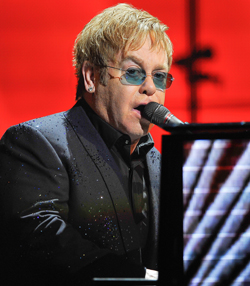
No mics are used on Blossom, which is a good thing really, because the stage volume around the piano is so loud that their presence would only promote unwanted bleed. For the record, the source of all this unbridled gain is a collection of Clair 12 AMS wedges.
“I use two stereo mixes for Elton,” relates monitor engineer Richardson. “The first runs through a pair of single 12 AMS wedges, and is just his vocals and vocal reverb return only. Nothing else goes in there. I use a pair of double-12 Clair AMS wedges for the second stereo mix, and it’s for a band mix including his piano. If there’s anything truly characteristic of Elton’s mix, it’s the fact that it’s loud. It’s always been like that, and he wants it that way. He has a history of blowing up studio monitors, headphones, wedges, you name it.”
A historian of monitoring trends in the business, Richardson has carefully charted the progression of John’s escalating use of sonic horsepower onstage and applied lessons learned to his own strategies in use today.
“I took this job 17 years ago,” he notes, “and at that time they were using S4s. With the backlash you got off of those cabinets onstage, you had to adopt a piercing, high-end sound in order to hear yourself. As we moved away from S4s, however, Elton still thought he wanted to hear this wailing, high-pitched sound onstage, but he really didn’t need to anymore. What he thought he wanted to hear wasn’t necessary.
“I took it as my task to slowly draw him away from the needs of his past, and I’ve been successful to a large degree. Now it’s still loud, but a good kind of loud. Not an annoying rip-your-head-off loud.”
The Real Art
Working from a Yamaha PM1D, Richardson does all of his cueing on headphones, this to provide him with the advantage of hearing feedback before John does, and also because it gives him a chance to react quickly if things are getting too loud in the house.
“When it’s getting loud in the house it creates this umbrella effect that starts enveloping the stage,” he explains. “When that starts happening, I can hear it immediately in my headphones, and I can call Matt out front and ask him to pull it back 2 dB. That’ll make all the difference in the world, and then we’re not battling each other. If it doesn’t get turned down out front, then I’d have to turn the stage up, and it would be all downhill from there.”
_2_LR.jpg)
Beyond the full-frontal wedge approach, most of the remaining stage is on in-ear monitoring, with band members each giving expression to their own preferences on earbuds. Sennheiser G3 wireless systems handle transmission and receiving chores.
Back out front, Herr notes that all things loud considered, it’s still a joy working with the “handcrafted” old school, organic sound emanating from the stage. “For what we do it would be a shame to take it out of the analog world,” he adds on a parting note. “A lot of people see my gear and say ‘what the hell, you’re pretty young to be using that stuff’ [Herr is 38]. But this is my 20th year at Clair so I’ve been doing this long enough, and know a lot of the people who pioneered this route.
“I think a lot of times the digital world takes the fun out of mixing. You become more of an operator. This band never plays a song the same way twice. You have to be on your toes constantly, moving faders and keeping pace with everything transpiring on stage. This is a place to practice the real art of live sound.”
Gregory A. DeTogne is a writer and editor who has served the pro audio industry for the past 30 years.

.jpg)